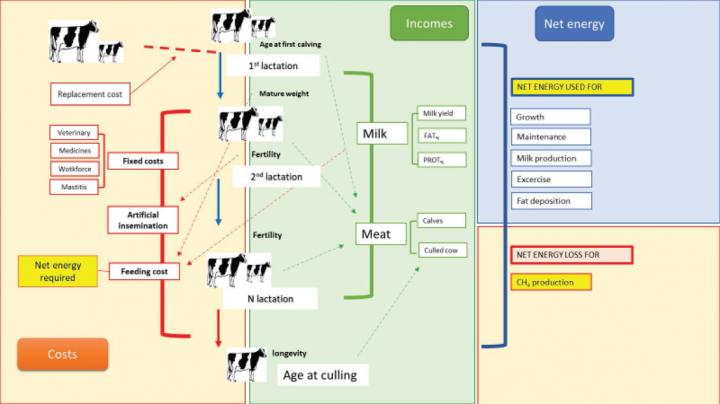Study targets reducing methane production by 20 percent in 10 years according to research in the Journal of Dairy Science®

Credit: Journal of Dairy Science
Philadelphia, July 22, 2020 – Researchers in Spain propose mitigating methane production by dairy cattle through breeding. In an article appearing in the Journal of Dairy Science, scientists are targeting reduction of enteric methane in the breeding objectives for dairy cattle to select for animals that use feed more efficiently and thus produce less methane. Because livestock farming contributes 13 percent of global greenhouse gas (GHG) emissions, selective breeding can reduce those emissions while increasing milk output.
Methane from enteric fermentation is considered the main contributor to GHG coming from ruminants. These emissions contribute to global warming and represent a loss of dietary energy in ruminants. “Current selection pressure is increasing total methane production in the population of dairy cows but is reducing methane intensity (per kilogram of milk) due to higher productive levels of each cow. A reduction of methane in the breeding goals should also be included in the selection indices,” said lead author Oscar González-Recio, PhD, Department of Animal Breeding, Instituto Nacional de Investigación y Tecnología Agraria y Alimentaria (INIA), Madrid, Spain.
Evaluation of the genetic traits and economic response of the traits in the selection index were considered in this study that used genetic parameters estimated with 4,540 records from 1,501 cows. The project was funded by the Spanish National Plan of Research, Development, and Innovation 2013-2020. While methane production is necessary to maintain rumen homeostasis, total methane emissions are expected to decrease four to six percent in 10 years due to increased milk production per cow. If annual methane production per cow is included in breeding goals and ad hoc weights are placed on methane production, GHG emission from cattle could be reduced by 20 percent in 10 years.
Dr. González-Recio added that “increasing per-cow productivity may reduce the number of cows needed per billion kilograms of milk produced, contributing to mitigation of GHG emissions, but this is not enough. If no action is taken, the genetic potential for methane production is expected to increase.”
While the biological limit of methane production remains unknown, this study shows the potential for including environmental traits in selection indices while retaining populations of cows that are profitable for producers.
###
Media Contact
Eileen Leahy
[email protected]
Related Journal Article
http://dx.




